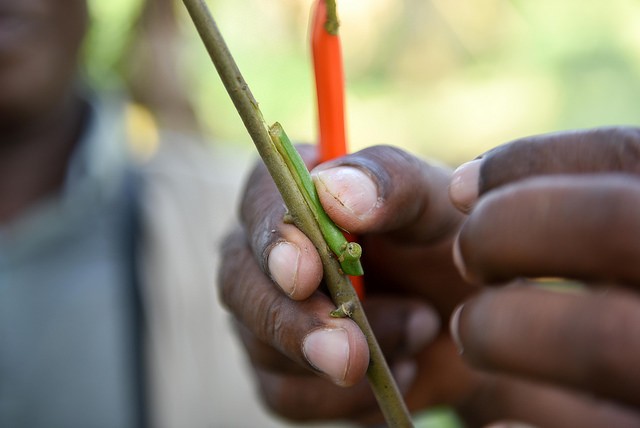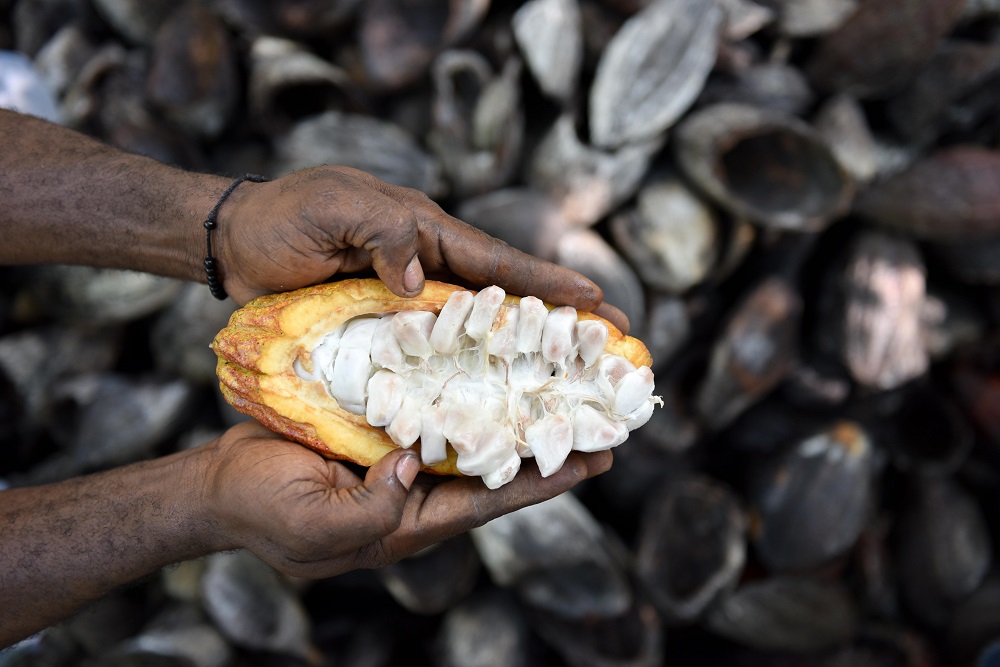Basics
Climate-Smart Cocoa (CSC) is the adaptation of Climate-Smart Agriculture (CSA) practices to the management of Theobroma Cacao (cocoa). The CSC program rests on the same three pillars that support CSA; namely, productivity, adaptation, and mitigation.
Basics
What is climate-smart cocoa?
Introduction
Climate-Smart Cocoa (CSC) is the adaptation of Climate-Smart Agriculture (CSA) practices to the management of Theobroma Cacao (cocoa). CSC rests on the same three pillars that support CSA; namely, productivity, adaptation, and mitigation. The productivity pillar seeks to optimize yields and quality in relation to the inputs needed. In other words, the ratio of the value of production and the cost of inputs increases (output-input ratio). Higher farm profitability should lead to a decent income that ensures food security, higher wages, and investment capacity. Adaptation embodies the need for long-term resilience to climate change, as well as farmer capacity to minimize short-term risks and prevent long-term stresses. Finally, wherever possible, CSC ties in the mitigation of greenhouse gas emissions to the previous objectives, helping to reduce the contribution of cocoa to climate change. Finally, the CSC program works alongside a number of programs, such as the UTZ Sector Partnerships program and the Cocoa and Forests Initiative to attain the aforementioned objectives.
The three pillars of CSA
Productivity: CSC aims to increase the output-input ratio of cocoa farming and farmer incomes sustainably; avoiding the substantial negative environmental and social consequences that the expansion of monoculture and deforestation forebode. Stakeholders should look to such sustainable cocoa intensification for improved farmer well-being, supply resilience, and forest land conservation. Productivity is sustainable given the co-occurrence of: a) optimized yields and quality in relation to inputs required, b) farms allow for earning a decent income, wages and reinvestment in the farm, c) negative social and environmental impacts related to production are minimized and externalities are accounted for, d) maintaining productivity over the medium and long-term is prioritized over short-term yield gains.
Adaptation: The negative consequences of climate change (e.g. temperature increases, rainfall variation, drought…) on agricultural production are uncontested. CSC promotes context specific adaptive capacity programs for farmers to confront short and long-term risks, to maintain the integrity of their plots, and to provide and protect ecosystem services.
Mitigation: Cocoa farming has had a disastrous toll on the ecosystems of tropical forests. CSC does not only go against the practice of deforestation, but it also encourages an increase in ecosystem services and monoculture conversions to agroforestry. The ramifications are plenty: increased carbon storage, virgin forest and national parks preservation, biodiversity protection, production of better quality, etc. CSC ensures each product derived from cocoa has a much smaller environmental cost.
Key characteristics of CSA
CSC addresses multiple goals and manages trade-offs: Ecosystem services and yields are widely considered to be a fundamental trade-off in cocoa farming. The less canopy cover the higher yields are expected to become. CSC seeks to clarify this notion, which is likely based on a parabolic relationship rather than a strict trade-off. CSC underscores the importance of shade trees in the reduction of environmental risks and promoting shade levels consistent with productivity goals.
CSC maintains ecosystem services: Cocoa production has doubled during the last two decades, keeping pace with the steadily increasing global demand. Unfortunately, these and previous historic production increases were attained through increases in cultivation area, often involving deforestation, instead of increases in yields per hectare (Lojka, et al. 2018). The current trend toward full-sun production systems may increase yields and incomes in the short-term but constitutes a threat to forest connectivity and biodiversity.
CSC has multiple entry points at different levels: CSC is a comprehensive approach to cocoa farming and is not limited to recommendations for the improvement of farming practices. CSC has multiple entry points, including the development of technologies, climate change modelling, certification and insurance schemes, value chains, and improving political and institutional environments. Integration of the multiple levels improves the status quo in the short-term and helps maintain it in the longer-term.
CSC is context specific: Cocoa is cultivated in approximately 60 countries. The CSC approach considers intra- and intercountry variations in the climate and institutional environment to ensure recommendations remain aligned with climate-smart objectives. Ecosystem, landscape, institutional and political interactions result in certain interventions not being climate-smart everywhere. These interactions should be taken into account when considering CSC in different contexts.
CSC engages women and marginalised groups: Gender issues need to be addressed in the planning and implementation of climate-smart practices in cocoa, as women and men are affected and respond differently to climate change-related risks. CSC should empower women of cocoa farming families by improving their decision-making power, technical capabilities, and access to resources. The specific issues faced by migrant farming communities need also be considered in CSC approaches, particularly in West Africa.
Basics
Why climate-smart cocoa?
CSC addresses the relationship between cocoa farming, poverty and climate change
The five largest cocoa producing countries are classified as lower-middle income by the World Bank (2017). Farmers in these countries are among the most vulnerable segments of the population. In Côte d’Ivoire, for example, farmers’ incomes generally fall below the $2/day poverty line set by the World Bank (True Price and IDH, 2016) making food security a very real concern for smallholder households. The CSC approach addresses poverty among cocoa farmers from multiple angles. First, CSC seeks to increase yields and yield quality to raise farmer incomes. Second, increasing the adaptation capacity of farmers to sustain higher incomes in the face of short and long-terms risks. Third, CSC involves multiple levels and entry points, including political and institutional enabling environments to facilitate training and extension services.
CSC addresses food security, misdistribution and malnutrition
CSC addresses the relation between climate change and cocoa farming
Depending on how it is produced, cocoa production can lead to the emission of considerable amounts of greenhouse gases (GHG). CSC reduces emisssions in two ways. First, as has already been mentioned, CSC advocates for the conversion of fallow land, the reconditioning of old cocoa farms, and re-agroforestry, rejecting expansion through deforestation, which would liberate carbon stocks and result in an array of other negative environmental consequences. Second, in the establishment phase of a cocoa farm CSC promotes the planting of shade trees in unshaded plots and pruning of trees already on a farm instead of cutting them down or burning them (i.e. slash-and-mulch instead of slash-and-burn, significantly reducing GHG emissions (Jacobi, et al. 2014)). Cocoa agroforests have higher overall carbon stocks than full-sun farms (Gockowski and Sonwa, 2011). Moreover, the transformation of forestland into low shade or full-sun cocoa plantations results in higher biodiversity loss and carbon emissions than agroforestry (Schroth, et al. 2016).
In the opposite direction, extreme weather events are likely to become more common as climate change progresses along with increasing temperatures, prolonged dry seasons, erratic rainfall, etc. Cocoa suitability maps based on climate change models showcase the effect climate change is expected to have on the locations where cocoa is currently cultivated:
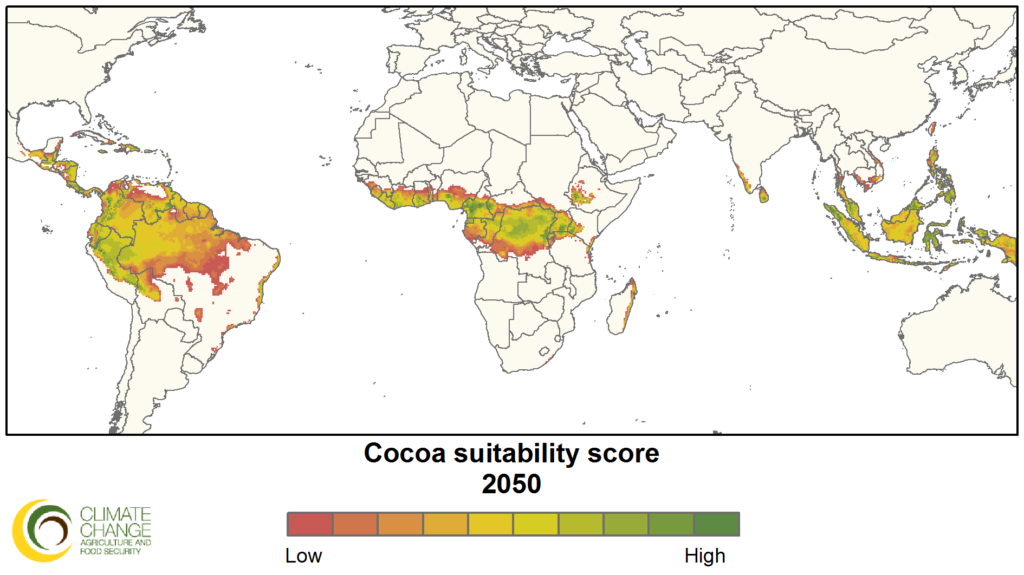
(Bunn, et al. 2017)
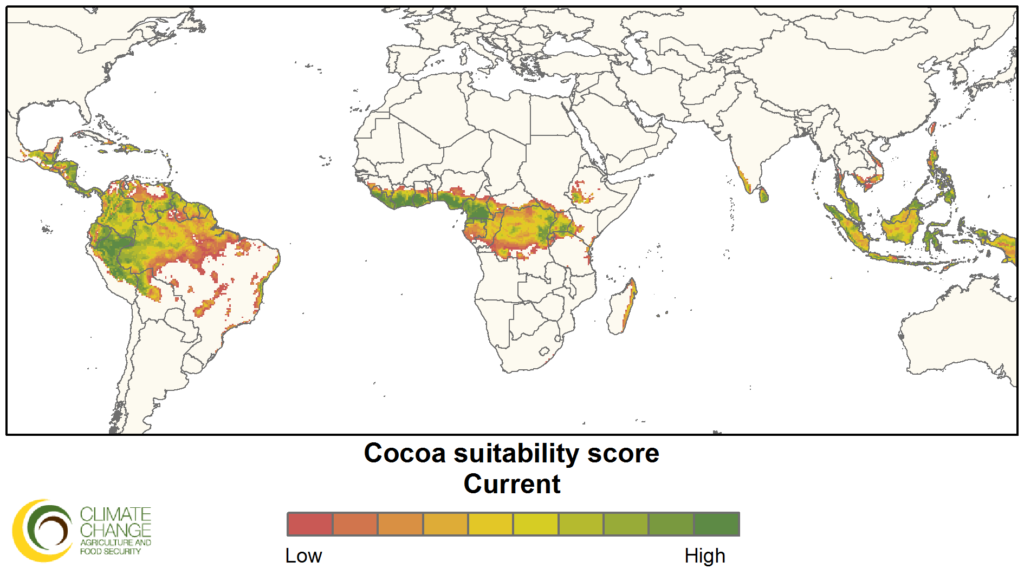 (Bunn, et al. 2017)
(Bunn, et al. 2017)
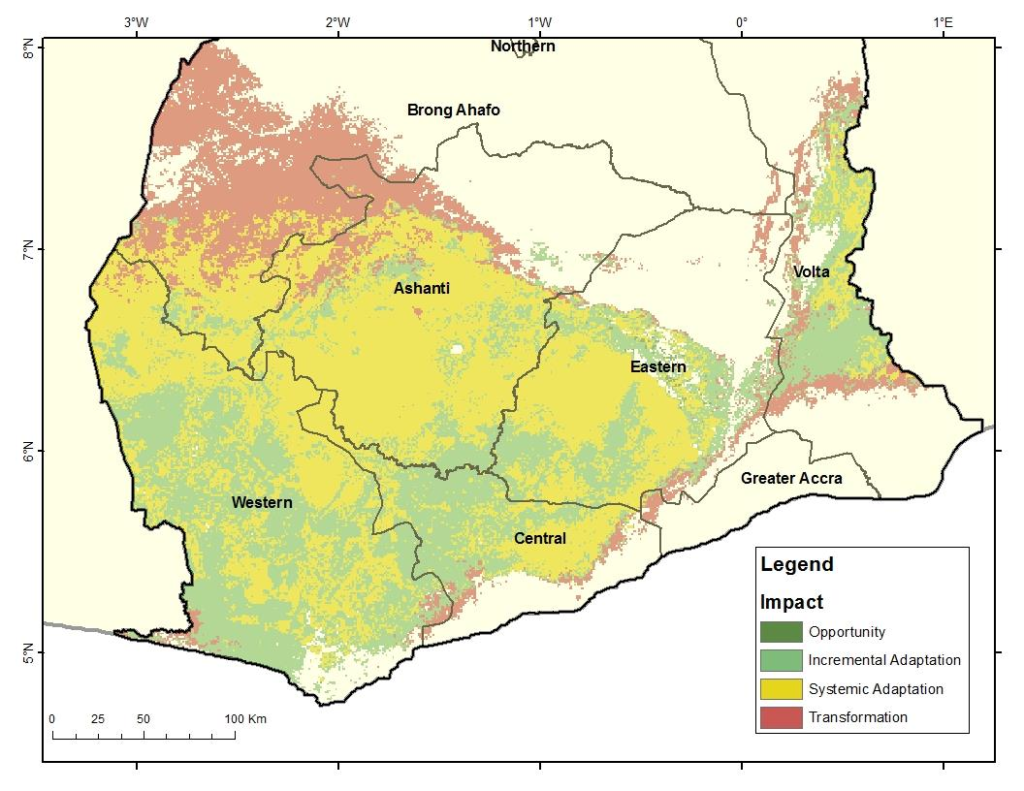 Zones of most likely climate impact on cocoa suitability by the 2050s relative to 1950-2000 in Ghana. The scenario was obtained by choosing the most frequent change observed among the 19 climate projections. (Bunn, et al. 2018)
Zones of most likely climate impact on cocoa suitability by the 2050s relative to 1950-2000 in Ghana. The scenario was obtained by choosing the most frequent change observed among the 19 climate projections. (Bunn, et al. 2018)
Transformation zones are areas which are currently suitable but are likely to become very unsuitable in the future; replacing cocoa with a different crop is the recommended approach in these cases. Systemic adaptation locations allow for cocoa cultivation, but cultivation methods need to be adapted to the expected changes in climate. In incremental adaptation/Absorb zones the climate zone will remain suitable if the climate remains the same; some adaptation is recommended to increase cocoa resilience. Finally, opportunity zones are areas not suitable for cocoa which are estimated to become suitable in the future (Bunn, 2018). 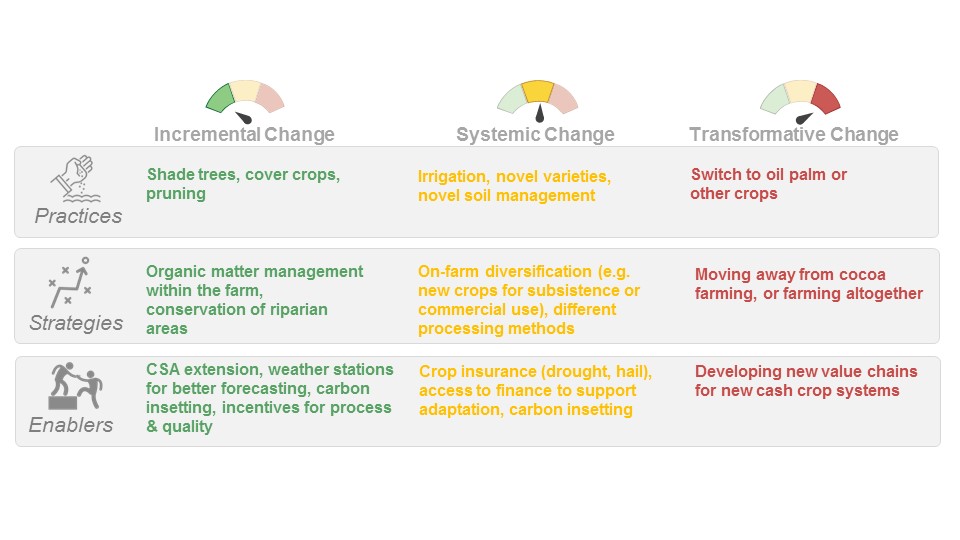
CSC addresses the cocoa life-cycle
The life-cycle of cocoa has been described as following a pattern of boom and bust (Clough, et al. 2009). The first stage, where yields are high, occurs a few years after cocoa is planted on fallow or deforested land. As trees go through maturity and begin to age, yields drop significantly and susceptibility to pests and diseases increases. This is the way the second stage –the bust- begins. Increasingly, full-sun or low-shade agroforestry is the adopted production system. In these systems, the characteristics of each stage are intensified due to the positive effects of light interception on tree yields in the first stage and the negative effects of high plant stress and disease susceptibility in the second stage. At the end of the cocoa life-cycle, plots are either abandoned or used for different crops because deterioration of the soil makes replanting cocoa difficult and costly. CSC includes soil management as a priority to improve the conditions of cocoa plots for replanting, thereby reducing incentives for forest encroachment thereby minimizing the damage caused prior to the first stage of the cocoa life-cycle. CSC promoted cocoa agroforestry production systems to sustain yields and extend the life-cycle of cocoa. Effectively, CSC shifts the cocoa life cycle from “boom and bust” to regrowth and sustainable maturity.
CSC adapts to weather forecasts
The effectiveness of many farm management practices depends on the weather during and after their implementation. The distribution of fertilizer on the farm, for example, will be less effective if rains occurring shortly after washing it away. Replanting will not be very successful if a prolonged dry period sets in. Current cocoa farm management is often too reliant on calendars to implement good farming practices. CSC encourages the availability of weather forecasts and the adaptation of farm management to weather information.
Basics
How is CSC different?
Introduction
The Climate-Smart Cocoa Program for West Africa and Latin America is the fruit of a partnership between the World Cocoa Foundation, USAID, and nine WCF cocoa industry partners. It is supported by the Learning community for Private engagement in CSA and the Alliance for Resilient Coffee. There is expansive and thorough collaboration on CSC from companies and organizations for tool and policy development. In its essence, the CSC Program seeks to engage cocoa smallholders in the adoption of CSC recommended practices with the support of private sector investment to ensure a sustainable future for cocoa production.
Similarities are often drawn between Climate-Smart Agriculture (CSA) and the concept of Good Agricultural Practices (GAP). While there can be overlap in the practices that are recommended as GAPs, CSC plans are developed with the specific characteristics and most prevalent risks of each climate impact zone in mind, leaving room for the producer to prioritize different options according to his needs and situation. Furthermore, CSC goes beyond the farm level with its additional consideration of the landscape level and the whole supply chain. Moreover, monitoring and evaluation of outcomes, as well as the exploration of other potential CSC themes are also part of the CSC program (WCF, 2017).
The three big differences
CSC= Sustainable Agriculture + Resilience – Emissions
Outcomes, synergies and trade-offs: The CSC approach seeks to improve outcomes on its three goals simultaneously. The scope of CSC goes beyond the farm level and assesses interactions, synergies, and trade-offs between the three objectives, stakeholders at different levels. CSC interventions at the farms level should also consider landscape effects, for example, as well as synergies between farmers and other decision-makers.
Support structure: The UTZ Sector Partnerships Program works alongside CSC. The themes of Climate change adaptation and water management, Living wage, and Sustainable productivity align with the pillars previously presented for CSC. The promotion of sustainable farming practices at all levels of the value chain is key in CSC and the UTZ Sector Partnerships Program. The objective is to ensure that sustainable farming practices that improve farmer livelihoods become the norm in cocoa producing countries.

